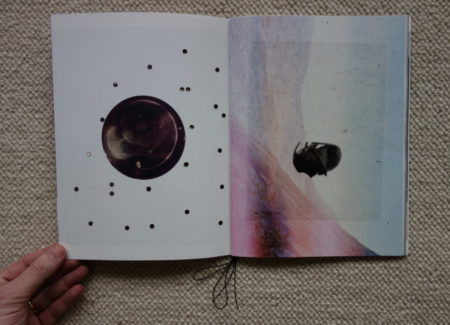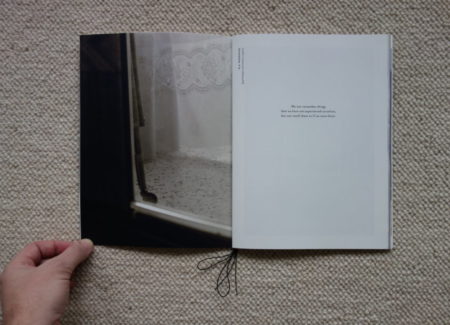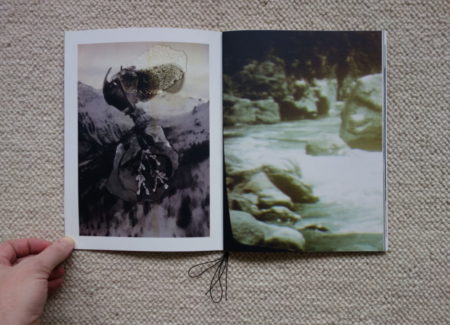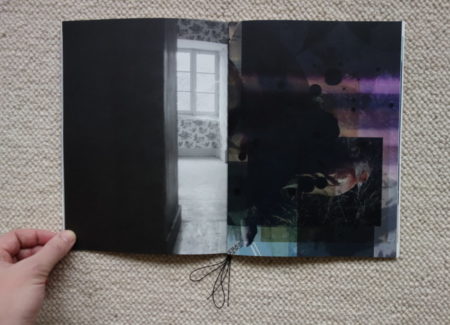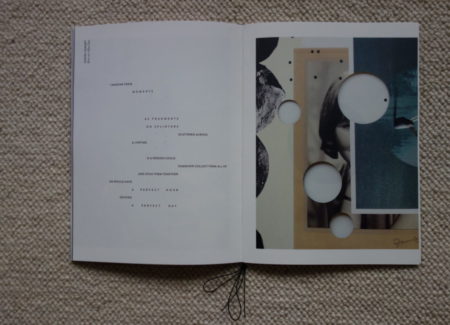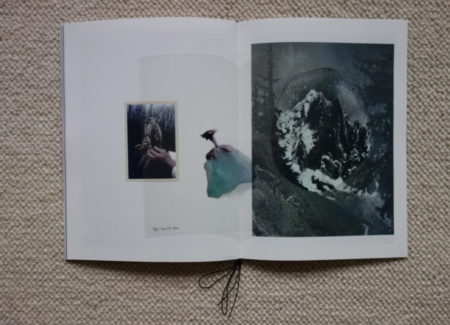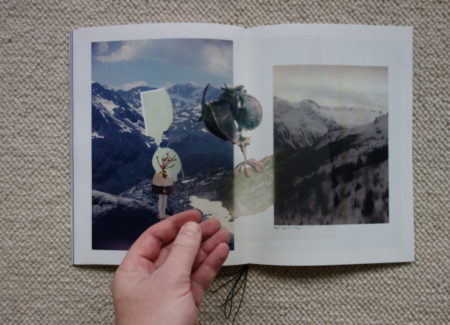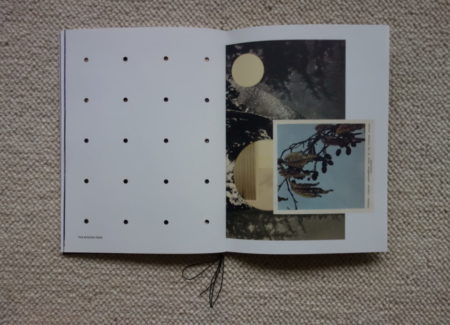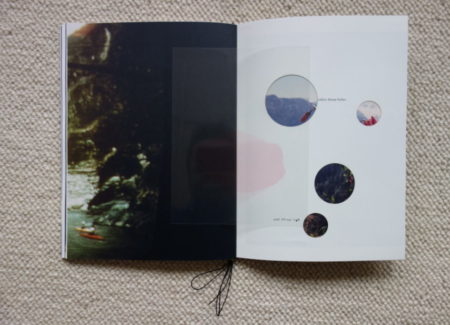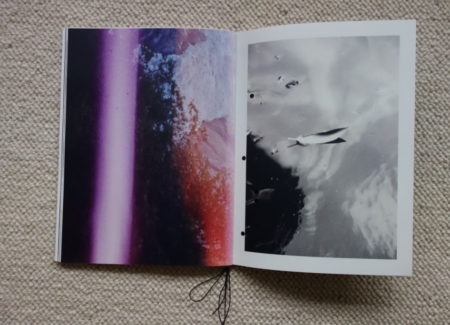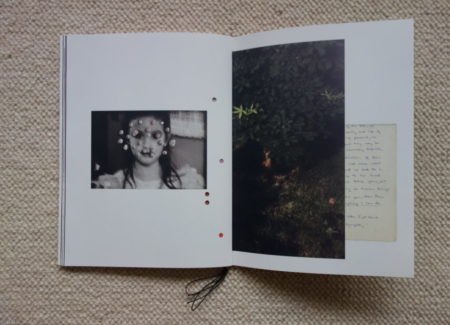JTF (just the facts): Self-published in 2017 (here). Card stock cover, 72 loose pages (some with punched through holes), tied together with a thin black elastic band, with 4 interleaved acrylic sheets and a glassine envelope containing the punched hole remainders. Includes a selection of quotes, poems, and short texts. In an edition of 250 copies (English). A Dutch version of the book was published in 2016 (48 pages, 50 copies). (Cover and spread shots below.)
Comments/Context: Of all the art forms, photography has always had a particularly complex relationship with human memory. Given their ability to faithfully record the events of our lives, photographs have become indispensable repositories of our memories, and by their very creation and reuse, they have turned memory in on itself. We begin by remembering events as they occurred, and as those memories inevitably fade, we return to our pictures of those moments to refresh our recollection. As the years pass, the original memories become impossible to retrieve and what we “remember” is increasingly what the photographs show us. So the family album photographs become stand-ins for actual memories, and as we share those pictures with others, we collectively abstract real events into common thumbnails and placeholders, which are then mixed in with and diluted by countless other individual memories both related and unrelated.
This conceptual framework lies at the heart of Saskia Overzee and Amanda Butterworth’s innovative new photobook Collective Memory. Employing a variety of archival photographs and other imagery, the book attempts to probe the elusive process of memory – there is no direct “subject” per se; instead the book is more a visual evocation of the uncertainty of how images connect us to memories and to each other. Such an idea might very well sound overly precious, but the artist pair has executed their project with an uncommon level of flair and sophistication.
In many ways, Collective Memory operates in a similar manner to a shoebox of old photographs tucked under the bed. When opened, the images feel randomly shuffled together, their original order or context now entirely lost. Pictures of wilted flowers, childhood trips, family pets, and faded (and now not quite identifiable) landscapes form the infrastructure of memory – these are the images that appear to show us our mother standing by the river (when she was young), our favorite butterfly net (when we were eight years old), our cat (now long dead), and the woods in our backyard (two or three houses ago).
Intermingled with these recognizable elements are images that are less rooted. Repeated glimpses through windows, doorways, and curtains leave us hanging, our vision not quite able to get around the corner to see what we should be remembering. These shots are mixed with photographs altered by blur, process drips, and light flares, representing the eroding vagaries of memory – some pictures are just too decayed to entirely make out. Overzee and Butterworth then go further, creating collages of images that fuse alternate histories together and layered tangles of overlapped pictures that become almost too dense to unpack. It’s as if the pictures (and the associated memories) have become unglued from their rigid place in the family album, sticking together in one largely unresolvable pile.
Additional smart design elements reinforce these feelings of compression and fusion. Holes of various sizes (from roughly the size of a pencil eraser to the size of cracker) have been randomly cut through the pages, creating two related effects – we can now see through one image to another underneath, thereby intermingling the two in our minds, and the original picture is partially cut away and disrupted, further reducing its legibility. In both cases, the memories get cracked, distorted, and damaged, resulting in a slow loss of meaning. The hole remainders have been helpfully gathered into a glassine pouch at the center of the book, as if we might try to match them up and “fix” the holes. Such a process of reconstruction is of course futile, which is I think the point – the image fragments are like broken pieces of memories we just can’t fit back together.
A handful of clear acrylic sheets have also been intermittently included in the book, each printed with an image from a sequence of a succulent attached to a rock as it grows and blooms. The sheets are inevitably out of order, so the step-wise progression of time is deliberately upended, scrambling our “memory” of the natural events.
This idea of time being bent back on itself takes more defined shape in the non-linear nature of the entire photobook. Instructions in the center of the book encourage us to remove the loose elastic binding and reshuffle the pages, thereby creating a “new book”. While other photobooks have used this falling-apart-in-your-hands effect with varying degrees of success, here it makes perfect sense. We can infinitely reorder the included images to create an entirely new pattern of memories – memory is inherently changeable (especially in the context of a group of people remembering the same events), and the book’s jumbled construction mimics this oscillating reality.
This photobook is a compelling example of a growing genre of artist books that are combining found imagery and inspired design into a platform for complex visual storytelling. These photobooks aren’t monographic bodies of superlative work, designed to celebrate the quality of the image making. They are instead compendiums of photographic ideas and ephemera that are ordered and constructed in such a way that they excavate histories, reimagine forgotten pasts, or make persuasive arguments – in short, they are leveraging photography’s power as a language of its own to create meta-stories.
In the end, Collective Memory is effective because it is so intentionally elusive. Even if we reshuffle the book time and time again, its ultimate meanings and conclusions fail to completely coalesce, leaving us with prickly hints and echoes, just like those that haunt our own minds.
Collector’s POV: Saskia Overzee and Amanda Butterworth do not appear to have gallery representation at this time. Interested collectors should likely follow up directly with the artists via their respective websites (linked in the sidebar).



